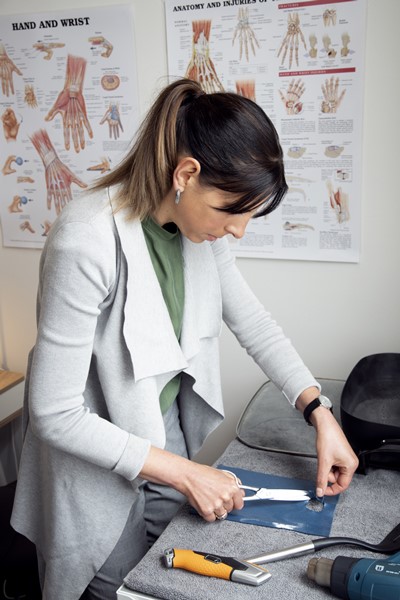WHAT ARE SPLINTS ANYWAY?
A tool for injury recovery
As a Hand Therapist I have made thousands of custom splints in my career and they are very familiar to me, but what I have learnt over the years is that many clients have never seen or even heard of a thermoplastic splint. So they often don’t realise it is an option available to aid recovery after an injury.
Splints are often the most comfortable and effective way to manage an injury or condition, but what is a splint? Splints are custom made braces designed to support or immobilise your hand or wrist to facilitate your recovery.

Materials
Splints can be made out of different types of thermoplastics, which is a heat sensitive material. When the thermoplastic is heated it becomes malleable and can be moulded onto an injured body part such as a finger, thumb or wrist. Velcro straps are attached to your splint using a heat gun and this will ensure your splint is held securely in place. Thermoplastic comes in a range of different colours from black and grey to hot pink and (my favourite) purple. The thickness and properties of thermoplastic varies between brands, which allows your Hand Therapist to choose the best thermoplastic material to meet your needs.

Why choose a splint over plaster?
The benefit of a splint compared to a plaster is that a splint is much lighter and more comfortable to wear. Plasters cannot be easily removed, where as a splint can be easily removed to check wound healing, fracture healing and for hygiene. As your injury or condition heals, having a splint allows you to be able to take it off when it is safe to do so, (for example when watching TV) and then you can put it back on at work, school or when playing sport and more protection is required.
Which conditions require the aid of a splint?
Injuries and conditions that can managed with a custom thermoplastic splint include:
- Finger and thumb fractures
- Buckle fractures
- Wrist fractures (distal radial fractures)
- DeQuervain’s
- Carpal Tunnel Syndrome
- Hand and thumb arthritis
- Wrist pain
- Mallet injures
- Trigger Finger
- Finger dislocations
- Sports injuries
